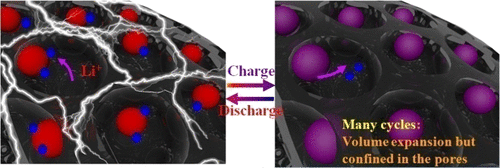当前位置:
X-MOL 学术
›
ACS Appl. Mater. Interfaces
›
论文详情
Our official English website, www.x-mol.net, welcomes your feedback! (Note: you will need to create a separate account there.)
Pulverization Control by Confining Fe3O4 Nanoparticles Individually into Macropores of Hollow Carbon Spheres for High-Performance Li-Ion Batteries
ACS Applied Materials & Interfaces ( IF 9.5 ) Pub Date : 2018-01-12 00:00:00 , DOI: 10.1021/acsami.7b16530 Zhijun Yan 1 , Xiaobin Jiang 1 , Yan Dai 1 , Wu Xiao 1 , Xiangcun Li 1 , Naixu Du 1 , Gaohong He 1
ACS Applied Materials & Interfaces ( IF 9.5 ) Pub Date : 2018-01-12 00:00:00 , DOI: 10.1021/acsami.7b16530 Zhijun Yan 1 , Xiaobin Jiang 1 , Yan Dai 1 , Wu Xiao 1 , Xiangcun Li 1 , Naixu Du 1 , Gaohong He 1
Affiliation

|
In this article, double carbon shell hollow spheres which provide macropores (mC) for ultrasmall Fe3O4 nanoparticle (10–20 nm) encapsulation individually were first prepared (Fe3O4@mC). The well-constructed Fe3O4@mC electrode materials offer the feasibility to study the volume change, aggregation, and pulverization process of the active Fe3O4 nanoparticles for Li-ion storage in a confined space. Fe3O4@mC exhibits excellent electrochemical performances and delivers a high capacity of 645 mA h g–1 at 2 A g–1 after 1000 cycles. Even at 10 A g–1 or after 1000 cycles at 2 A g–1, the porous carbon structure was well maintained and no obvious aggregation and pulverization of the Fe3O4 nanoparticles was observed, although the volume of the active Fe3O4 particles was expanded to 40–60 nm compared to that of the original particles (10–20 nm). This can be due to the in situ embedment of one Fe3O4 nanoparticle into one macropore individually. The uniform dispersion and confinement of the Fe3O4 nanoparticles in the macropores of the carbon shell could effectively accommodate severe volume variations upon cycling and prevent self-aggregation and spreading out from the carbon shell during the expansion process of the nanoscale Fe3O4 particles, leading to improved capacity retention. Our work confirms the effectiveness for pulverization control by confining Fe3O4 nanoparticles individually into macropores to improve its Li-ion storage properties, providing a novel strategy for the design of new-structured anode materials for Li-ion batteries.
中文翻译:

通过将Fe 3 O 4纳米颗粒单独限制在高性能锂离子电池的空心碳球大孔中来控制粉碎
在本文中,首先制备了双碳壳空心球,该空心球为单个超小的Fe 3 O 4纳米颗粒(10–20 nm)的包封提供了大孔(mC)(Fe 3 O 4 @mC)。构造良好的Fe 3 O 4 @mC电极材料为研究有限空间中用于锂离子存储的活性Fe 3 O 4纳米粒子的体积变化,聚集和粉碎过程提供了可行性。Fe 3 O 4 @mC具有出色的电化学性能,在2 A g –1时可提供645 mA hg –1的高容量经过1000个周期。即使在10 A g –1或经过2 A g –1的1000次循环后,尽管活性Fe 3 O的体积仍保持了良好的多孔碳结构,并且未观察到明显的Fe 3 O 4纳米颗粒的聚集和粉碎。与原始粒子(10–20 nm)相比,有4个粒子扩展到40–60 nm。这可能是由于一种Fe 3 O 4纳米颗粒分别原位嵌入一个大孔中。Fe 3 O 4的均匀分散和约束碳壳大孔中的纳米颗粒可以有效地适应循环时严重的体积变化,并防止在纳米级Fe 3 O 4颗粒膨胀过程中自聚集和从碳壳中扩散出来,从而提高了容量保持率。我们的工作通过将Fe 3 O 4纳米颗粒单独限制在大孔中以改善其锂离子存储性能,从而证实了粉体控制的有效性,为设计用于锂离子电池的新型阳极材料提供了新的策略。
更新日期:2018-01-12
中文翻译:

通过将Fe 3 O 4纳米颗粒单独限制在高性能锂离子电池的空心碳球大孔中来控制粉碎
在本文中,首先制备了双碳壳空心球,该空心球为单个超小的Fe 3 O 4纳米颗粒(10–20 nm)的包封提供了大孔(mC)(Fe 3 O 4 @mC)。构造良好的Fe 3 O 4 @mC电极材料为研究有限空间中用于锂离子存储的活性Fe 3 O 4纳米粒子的体积变化,聚集和粉碎过程提供了可行性。Fe 3 O 4 @mC具有出色的电化学性能,在2 A g –1时可提供645 mA hg –1的高容量经过1000个周期。即使在10 A g –1或经过2 A g –1的1000次循环后,尽管活性Fe 3 O的体积仍保持了良好的多孔碳结构,并且未观察到明显的Fe 3 O 4纳米颗粒的聚集和粉碎。与原始粒子(10–20 nm)相比,有4个粒子扩展到40–60 nm。这可能是由于一种Fe 3 O 4纳米颗粒分别原位嵌入一个大孔中。Fe 3 O 4的均匀分散和约束碳壳大孔中的纳米颗粒可以有效地适应循环时严重的体积变化,并防止在纳米级Fe 3 O 4颗粒膨胀过程中自聚集和从碳壳中扩散出来,从而提高了容量保持率。我们的工作通过将Fe 3 O 4纳米颗粒单独限制在大孔中以改善其锂离子存储性能,从而证实了粉体控制的有效性,为设计用于锂离子电池的新型阳极材料提供了新的策略。



























 京公网安备 11010802027423号
京公网安备 11010802027423号